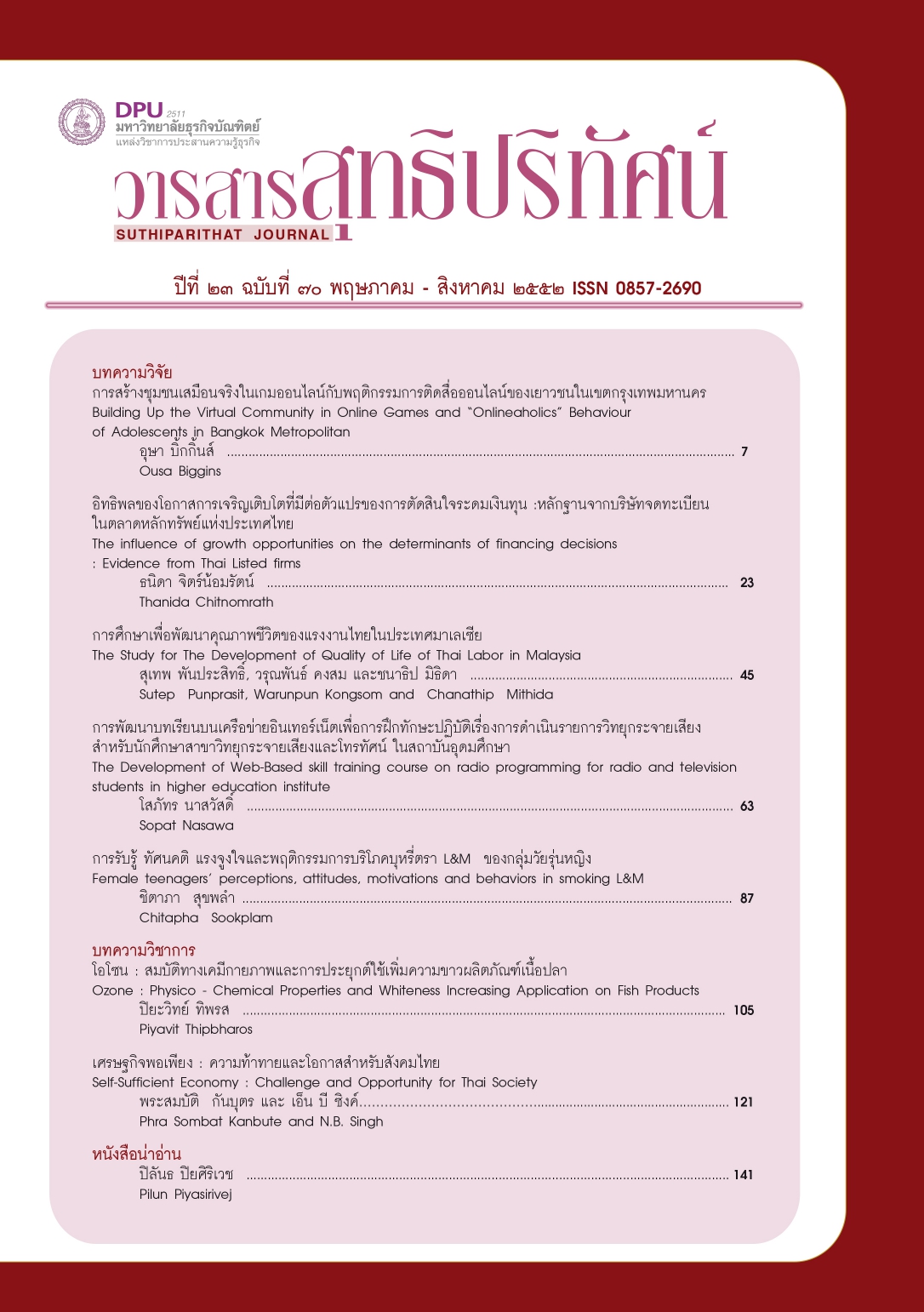อิทธิพลของโอกาสการเจริญเติบโตที่มีต่อตัวแปรของการตัดสินใจระดมเงินทุน : หลักฐานจากบริษัทจดทะเบียนในตลาดหลักทรัพย์แห่งประเทศไทย
คำสำคัญ:
ทฤษฎีแพคกิ้งออเดอร์, คุณลักษณะธุรกิจ, การตัดสินใจระดมเงินทุน, โอกาสการเจริญเติบโตบทคัดย่อ
การศึกษานี้ทดสอบว่า ตัวแปรของการตัดสินใจระดมเงินทุนแปร เปลี่ยนด้วยอิทธิพลของโอกาสการเจริญเติบโตหรือไม่ มันถูกตั้งสมมติฐานว่า บริษัทที่มีโอกาส ของการเจริญเติบโตแตกต่างกัน อาจจะมีตัวแปรของการตัดสินใจระดมเงินทุน แตกต่างกัน โดยอันดับแรก การศึกษานี้ได้ตรวจสอบตัวแปรของการตัดสินใจระดม เงินทุนตามคำพยากรณ์ของทฤษฎีแพคกิ้งออเดอร์ และพบว่า คุณลักษณะธุรกิจ 6 ลักษณะ ซึ่งประกอบด้วย ขนาดของธุรกิจ สภาพคล่อง ความเสี่ยงทางการเงิน สินทรัพย์ถาวร ความสามารถทำกำไร และนโยบายเงินปันผล คือ ตัวแปรที่มีนัย สำคัญของการตัดสินใจระดมเงินทุนของกลุ่มตัวอย่างบริษัทจดทะเบียนในตลาดหลักทรัพย์แห่งประเทศไทย จำนวน 220 บริษัท ที่ทำการศึกษาในระหว่างช่วง ปีพ.ศ. 2548 - 2550 ผลลัพธ์ที่ได้แสดงว่า กลุ่มตัวอย่างบริษัทจดทะเบียนของไทย ทำการตัดสินใจระดมเงินทุนตามกรอบแนวคิดของทฤษฎีแพคกิ้งออเดอร์ จากนั้นกลุ่มตัวอย่างถูกแบ่งออกเป็น 2 กลุ่ม คือ บริษัทที่มีการเจริญเติบโตเป็นบวก กับบริษัทที่มีการเจริญเติบโตเป็นลบ ตามอัตราการเจริญเติบโตของกำไรหลังหักภาษี เพื่อสำรวจ ตัวแปรของการตัดสินใจระดมเงินทุนในแต่ละกลุ่มตัวอย่างย่อย ผลลัพธ์จากการวิเคราะห์ชี้ว่า มีความแตกต่างกันในตัวแปรของการตัดสินใจระดมเงินทุนในกลุ่มตัวอย่างที่ถูกแบ่งสองประเภทนี้ กล่าวคือกลุ่มบริษัทที่มีการเจริญเติบโตเป็นบวก ได้ผลลัพธ์แบบเดียวกันกับผลลัพธ์ของกลุ่มตัวอย่างทั้งหมด ขณะที่กลุ่มบริษัทที่มีการเจริญเติบโตเป็นลบมีผลลัพธ์ที่แตกต่างออกไปสองคุณลักษณะทางธุรกิจคือ ความสามารถทำกำไร และนโยบายเงินปันผล ถูกพบว่าไม่ได้เป็นตัวแปรที่มีนัยสำคัญของการตัดสินใจระดมเงินทุนในกลุ่มบริษัทที่มีการเจริญเติบโตเป็นลบ เฉพาะขนาดของธุรกิจ สภาพคล่อง ความเสี่ยงทางการเงิน และสินทรัพย์ถาวรเท่านั้น คือตัวแปรที่สำคัญของบริษัทกลุ่มนี้ การค้นพบนี้สนับสนุนสมมติฐานของการศึกษาและชี้ว่าตัวแปรของการตัดสินใจระดมเงินทุนในกลุ่มบริษัทที่มีการเจริญเติบโตเป็นบวกมีความเข้มข้นมากกว่าตัวแปรของการตัดสินใจระดมเงินทุนในกลุ่มบริษัทที่มีการเจริญเติบโตเป็นลบ ดังนั้นผู้จัดการของบริษัทจดทะเบียนของไทย ควรตระหนักถึงประเด็นนี้เมื่อมีการใช้กลยุทธ์การระดมเงินทุน
เอกสารอ้างอิง
Bennett, M. and Donnelly, R. (1993). The determinants of capital structure: some UK evidence”. British Accounting Review, 25, 1. pp.43-59.
Bevan, A. and Danbolt, J. (2002). “Capital structure and its determinants in the United Kingdom - A decompositional analysis”. Applied Financial Economics, 12 ,3. pp.159-170.
Booth, L., Aivazian, V., and Demirguc-Kunt, A. and Maksimovic, V. (2001). ”Capital structure in developing countries”. Journal of Finance, 56.pp.87-130.
Brealey, R. A., Myers, S. C. and Marcus, A. J. (2005). Fundamentals of Corporate Finance (4th ed.). Boston: McGraw Hill Irwin.
Cassar, G. and Holmes, S. (2003). “Capital structure and financing of SMEs: Australian evidence”, Accounting and Finance, 43, 2. pp.123-147.
Coakes, S. J. (2005). SPSS Version 12 .0 for windows Analysis without Anguish. Perth, WA: John Wiley & sons Australia.
Coleman, S. and Cohn, R. (1999). Small firms’ use of financial leverage:evidence from the 199 3 national survey of small business finances. Working paper. Hartford, Connecticut: University of Hartford.
Delcoure, N. (2007). “The determinants of capital structure in transitional economies”. International review of Economics and Finance, 16.pp.400-415.
Donaldson, G. (1961). Corporate debt capacity: A study of Corporate debt policy and the determinants of Corporate debt capacity. Research paper. Boston: Graduate School of Business Administration, Harvard University.
Eldomiaty, I. (2007). “Determinants of corporate capital structure: evidence from an emerging economy”. International Journal of Commerce & Management, 17, 1/2. pp.25-43.
Eriotis, N. (2007). “How firm characteristics affect capital structure: an empirical study”. Managerial Finance, 33, 5. pp.321-331.
Field, A. (2005). Discovering Statistics Using SPSS (2nd ed.). London: Sage.
Frank, M. and Goyal, V. (2003). “Testing the pecking order theory of capital structure”. Journal of Financial Economics, 67. pp.217-48.
Frank, M. and Goyal, V. (2004). Capital structure decisions: Which factors are reliably important?. EFA 2004 Maastricht Meetings Paper no.2464. Tuck Contemporary Corporate Finance Issues III.
Gaud, P., Jani, E., Hoesli, M. and Bender, A. (2005). “The capital structure of Swiss firms: An empirical analysis using dynamic panel data”. European Financial Management, 11 . pp.51-69.
Green, S. B. (1991). “How many subjects does it take to do a regression analysis?”. Multivariate Behavioral Research, 26. pp.499-510.
Harris, M. and Raviv, A. (1990). “Capital structure and the informational role of debt”. Journal of Finance, 45, 2. pp.321-349.
Harris, M. and Raviv, A. (1991). “The theory of capital structure”. Journal of Finance, 46, 1. pp.297-355.
Mazur, K. (2007). The determinants of capital structure choice: evidence from Polish companies. Working Paper. Gdansk: Gdansk Institute for Market Economics.
Michaelas, N., Chittenden, F. and Poutziouris, P. (1999). “Financial policy and capital Structure choice in U.K. SMEs: empirical evidence from company panel data”. Small Business Economics, 12 . pp.113-130.
Mishra, C. S. and McConaughy, D. L. (1999). “Founding family control and capital structure: The risk of loss of control and the aversion to debt”. Entrepreneurship Theory and practice, 23, 4. pp.53-64.
Myers, S. C. (1984). “The capital structure puzzle”. Journal of Finance, 34, 3. pp.575-592.
Myers, S. C. (2003). “Financing of corporations”. In G. Constantinides, M. Harris and R. Stulz (eds.). Handbook of the economics of finance (1A, pp.215-253). Amsterdam: elsevier.
Myers, S. C. and Majluf, N.S. (1984). “Corporate financing and investment decisions when firms have information that investors do not have”. Journal of Financial Economics, 13. pp.187-221.
Rajan, G. and Zingales, L. (1995). “What do we know about capital structure: some evidence from international data”. Journal of Finance, 50, 5. pp.1421-1460.
Ross, S. A., Westerfield, R. W. and Jaffe, J.F. (2004). Corporate Finance (7th ed.). Boston: McGraw Hill Irwin.
ดาวน์โหลด
เผยแพร่แล้ว
รูปแบบการอ้างอิง
ฉบับ
ประเภทบทความ
สัญญาอนุญาต
เนื้อหาและข้อมูลในบทความที่ลงตีพิมพ์ในวารสารสุทธิปริทัศน์ ถือเป็นข้อคิดเห็นและความรับผิดชอบของผู้เขียนบทความโดยตรงซึ่งกองบรรณาธิการวารสาร ไม่จำเป็นต้องเห็นด้วย หรือร่วมรับผิดชอบใด ๆ
บทความ ข้อมูล เนื้อหา รูปภาพ ฯลฯ ที่ได้รับการตีพิมพ์ในวารสารสุทธิปริทัศน์ ถือเป็นลิขสิทธิ์ของวารสารสุทธิปริทัศน์หากบุคคลหรือหน่วยงานใดต้องการนำทั้งหมดหรือส่วนหนึ่งส่วนใดไปเผยแพร่ต่อหรือเพื่อกระทำการใด ๆ จะต้องได้รับอนุญาตเป็นลายลักษณ์อักษรจากวารสารสุทธิปริทัศน์ก่อนเท่านั้น







